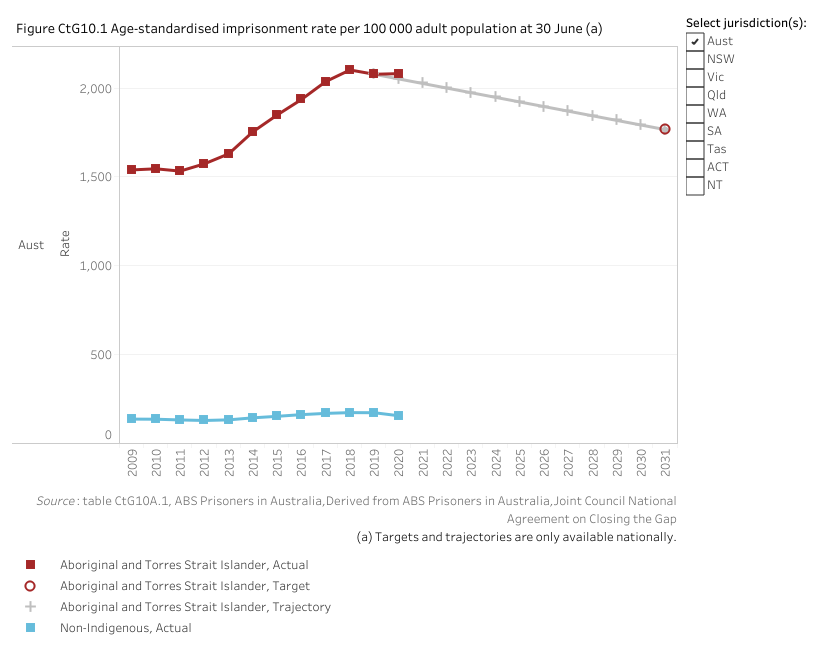TARGET 10
By 2031, reduce the rate of Aboriginal and Torres Strait Islander adults held in incarceration by at least 15 per cent
Dashboard snapshot: The data below are the most recent at the time of preparing the July 2021 report. Please go to the dashboard to access the current data.
Nationally at 30 June 2020, the age-standardised rate of Aboriginal and Torres Strait Islander prisoners was 2081.0 per 100 000 adult population (figure CtG10.1).
This is an increase from 2077.4 per 100 000 adult population in 2019 (the baseline year).
Nationally, based on the most recent year of data, this target is not on track to be met.

The assessment below reflects progress from the baseline year to the current year (ie improvement or otherwise in the rate). This differs to the national assessment against the trajectory (above), which compares the current year rate to the rate on the target trajectory at the same time period.
Target data specifications
Outcome: | Aboriginal and Torres Strait Islander people are not overrepresented in the criminal justice system. |
|---|---|
Target: | By 2031, reduce the rate of Aboriginal and Torres Strait Islander adults held in incarceration by at least 15 per cent. |
Indicator: | Age-standardised imprisonment rate. |
Measure: | The measure is defined as: Numerator — number of Aboriginal and Torres Strait Islander people aged 18 years and over in the legal custody of adult corrective services at 30 June Denominator — number of Aboriginal and Torres Strait Islander people aged 18 years and over at 30 June and is presented as an age-standardised rate per 100 000 people. |
Target established: | National Agreement on Closing the Gap July 2020 |
Latest dashboard update: | 23 June 2021 |
Indicator type: | Target |
Interpretation of change: | A low or decreasing rate is desirable. A decrease from the baseline year is an improvement. |
Data source(s): | Name (numerator): Prisoners in Australia Frequency: Annual Name (denominator): Estimates and Projections for Aboriginal and Torres Strait Islander population Frequency: Annual (data revised five-yearly) Documentation (links): https://www.abs.gov.au/statistics/people/crime-and-justice/prisoners-australia; |
Data provider: | Provider name: Australian Bureau of Statistics Provider area: Justice |
Baseline year: | 2019 (data revised in 2020) |
Target year: | 2031 |
Disaggregations: | State and territory and Australia, by Indigenous status. |
Computation: | Numerator divided by Denominator multiplied by 100 000 and age standardised Counting rules From 2019, in all states and territories, persons remanded or sentenced to adult custody are aged 18 years and over. In Queensland, prior to 2018, 'adult' referred to persons aged 17 years and over. Aboriginal and Torres Strait Islander rate: rates are calculated based on estimates of the Aboriginal and Torres Strait Islander population based on Series B projections for 30 June of the relevant calendar year. Non-Indigenous rate: rates are calculated based on estimates of the non-Indigenous population derived as the difference between the estimated resident population as at 31 March and the Aboriginal and Torres Strait Islander population projections as at 30 June for the relevant calendar year. Age-standardised rate: rates are calculated using the direct method of age standardisation. This is a standard methodology and consists of:
|
Data quality considerations: | It is not possible to reproduce the exact age-standardised rates as published in the ABS releases on Prisoners in Australia as the rates calculated using the method described above are based on unperturbed data, whereas the published data by age range is perturbed to protect the confidentiality of individuals. Comparisons of imprisonment rates should be made with care, especially for states and territories with relatively small Aboriginal and Torres Strait Islander populations. Small changes in prisoner numbers can cause variations in rates that do not accurately represent either real trends over time or consistent differences from other jurisdictions. |
Future reporting: | Additional disaggregations required for future reporting:
|
Supporting indicators
Driver
- Proportion of Aboriginal and Torres Strait Islander people charged by police
- Proportion of Aboriginal and Torres Strait Islander people convicted and sentenced
By offence and type of sentence - Aboriginal and Torres Strait Islander prisoner by offence type and number of offences
Most serious and other offences - Proportion of prisoners by legal status
Sentenced vs unsentenced and by sentence length - Number and rate of unique alleged offenders processed by police
- Proportion of prisoners previously incarcerated
Number of unique episodes of incarceration - Mental health, substance abuse issues, family history of incarceration, employment post release, history of victimisation
- Entry rate to incarceration
Newly sentenced to prison
Contextual information
- Rates of death in prison custody of Aboriginal and Torres Strait Islander prisoners
By cause of death - Proportion spending greater periods of time on remand
- Progress towards parity
